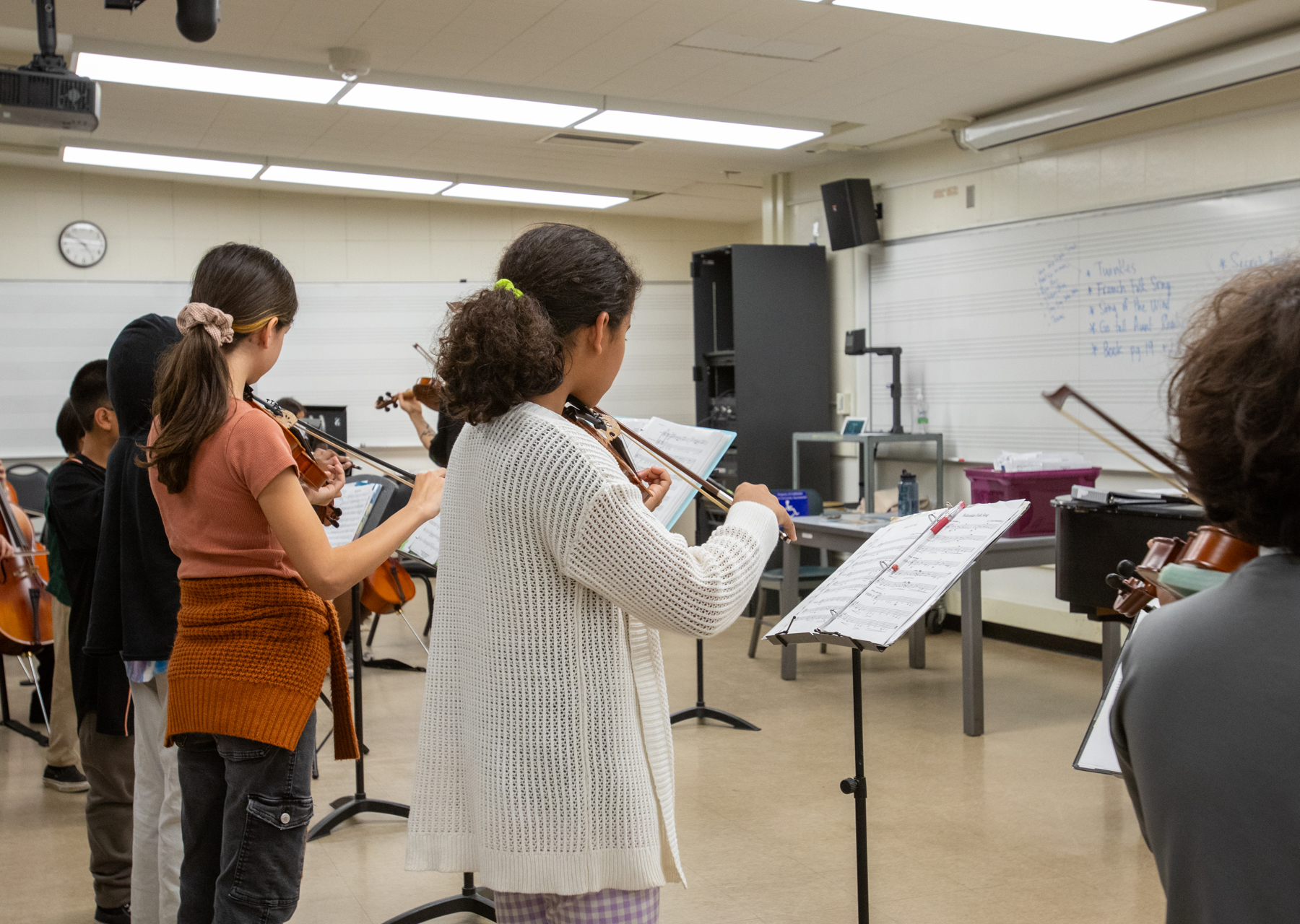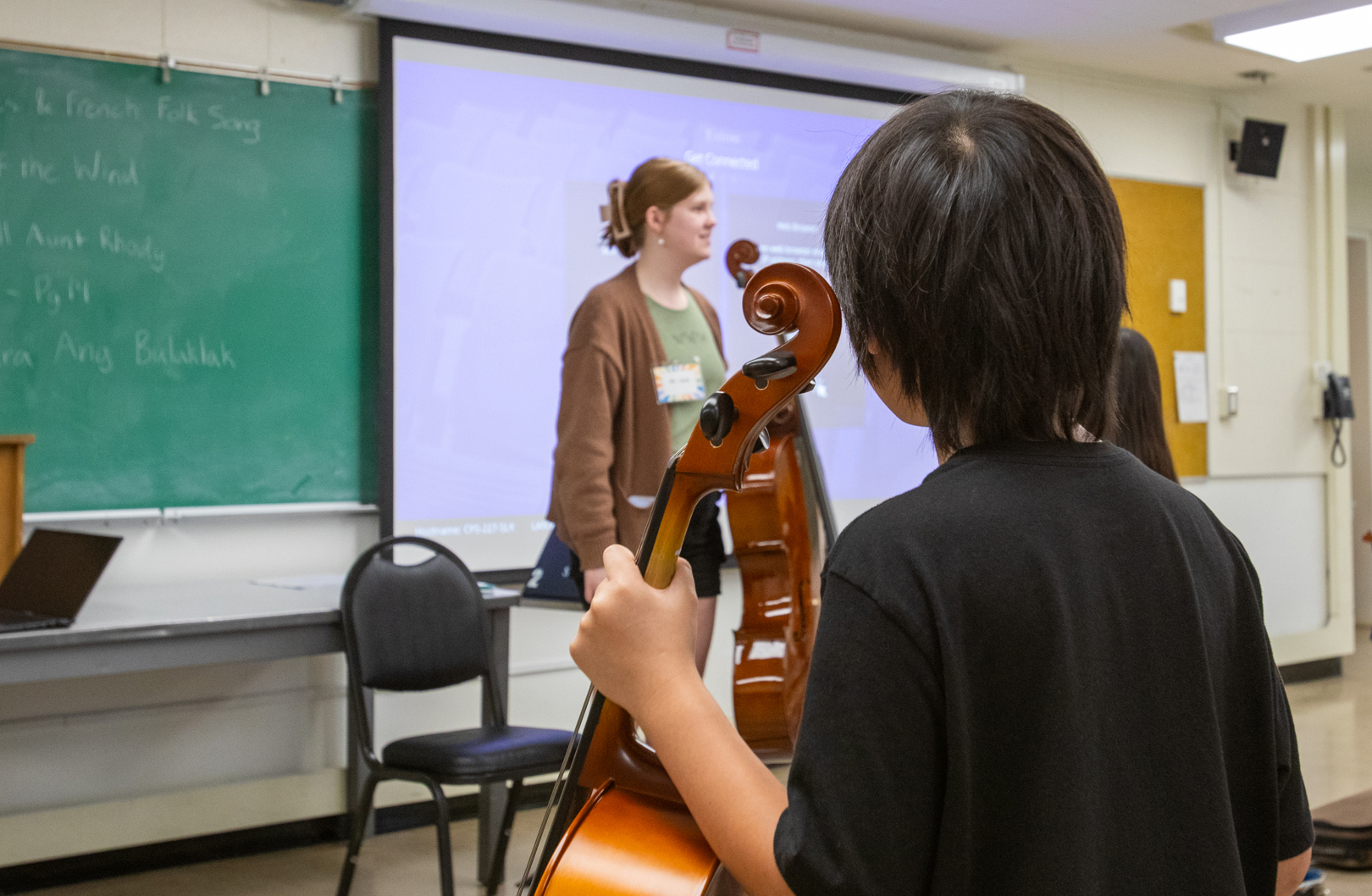Story Content
Sacramento State’s String Project expands access to music education for K-12 students

May 01, 2024
Two afternoons a week at Sacramento State, the corridors of Capistrano Hall are filled with the sounds of bows hitting strings and familiar tunes.
But the sounds are not from Sac State music students. They’re the sounds of local kids taking advantage of a unique University program that aims to expand access to the performing arts.
For over two decades, the Sac State String Project has provided K-12 students in the Sacramento region with high-quality, low-cost violin and cello lessons, filling a gap in music education that often leaves such instruction inaccessible to many.

The program embodies several of the University’s values. By offering affordable music lessons for those who may not otherwise be able to afford it, it works to increase diversity and inclusion in music. It prepares Sac State students for success after graduation by giving them valuable experience teaching music in a classroom.
The program also speaks to Sac State’s commitment to engaging the community, welcoming local kids on to campus to foster their creativity.
“Many of those kids in String Project, this is their outlet, whether they become musicians or not,” said Sheree Meyer, dean of the College of Arts and Letters. “We know that the arts can help develop other skill sets. It helps them behave better and perform better in all of their subjects.”
The program was founded in 2001, initially serving the North Sacramento-based Robla School District. At the time, that district lacked any music teachers, and Sac State offered a place where its students could learn to play.
The program eventually became open to all, and this year 50 students are enrolled. Though there is no age requirement or limitation, most of its participants are in the fourth through sixth grades. No prior experience in music is necessary.
The one-hour classes are held twice a week, Mondays and Wednesdays, during the academic year. The annual enrollment fee is $200, or about $4 a lesson, far less than private instruction.
“The idea is that it’s not cost-prohibitive,” said Music Lecturer Tim Stanley, one of two Sac State faculty members who are String Project “co-master teachers.”
“I did the math a number of years ago, and we were an order of magnitude cheaper than any other open, and nothing even comes close, except for a public school program.”
The classes are taught by Sac State student instructors, often a mix between music performance and music education majors. The student instructors are supervised by Stanley and Music Lecturer Tiffany Unarce Barry, the other co-master teacher, who work with the instructors for about 45 minutes before students arrive to go over the day’s lesson plan.
A concert is held at the end of each semester, which, Stanley said, is the first time many families have stepped foot on the Sac State campus.
“It shows that the doors (to Sac State) are open to them,” he said. “It shows that (Sac State is) for them in a way that many things couldn’t.”
Stanley, a cellist and longtime Sac State professor, has been with String Project since 2004. Barry, a vocalist and violinist, is in her first year with the program. She previously taught music in K-12 schools for 14 years. Sac State Professor of Music Andrew Luchansky serves as String Project’s director.
The program is supported primarily through fundraising. Student-teachers, who generally work four to six hours a week, are paid hourly through an Associated Students Inc. grant.
“We don’t just help these kids. If we train a good teacher, that training then takes care of every kid that teacher teaches.” -- Tim Stanley, Sac State Music lecturer and co-master teacher of the String Project
During the class, the Sac State student-teachers alternate between leading their own lessons and observing their peers’ teaching or working one-on-one with the participants. For most, it’s the first time they’ve had an opportunity to instruct an entire classroom full of young students.
“I’ve never had to work on classroom management before,” said Rachel Lewis, a third-year Music major with a dual concentration in performance and education. “I’ve always done private music lessons. I teach piano lessons (but) this is my first experience with classroom management, and it’s been interesting to figure out.”
That sentiment was shared by Emily Nikitchuk, a sophomore also majoring in music performance and music education who plans to eventually become a K-12 music teacher. The role, she said, involves not just instructing the kids on the day’s lesson, but also meeting their emotional and social needs. That can include anything from a moment of connection as a kid walks in the door to taking the extra time to reassure another who is worried they’re not progressing fast enough.
“I love the students. I think they’re my favorite part,” Nikitchuk said. “They’re really funny and I like seeing them grow as musicians.”
Through its student-teachers, Stanley said, String Project’s ability to transform the region is substantial.
“We don’t just help these kids. If we train a good teacher, that training then takes care of every kid that teacher teaches,” he said. “It’s an exponential growth process where every generation of teachers that we produce, produces a generation of musicians, and I can’t do that myself. It’s that kind of power I think is really, really vital.”
String Project, Barry said, creates a community of multiple generations of musicians – faculty, Sac State students and K-12 students – that she says is “magical.”
“It’s just one of those really cool things where we’re all learning from each other, and we’re all experiencing this journey in music,” she said. “Knowing that each person, whatever age or level they’re at, is bringing something to the space, that’s been my favorite thing. It’s beautiful to me.”
Editor's Pick
Media Resources
Faculty/Staff Resources
Looking for a Faculty Expert?
Contact University Communications
(916) 217-8366
communications@csus.edu


